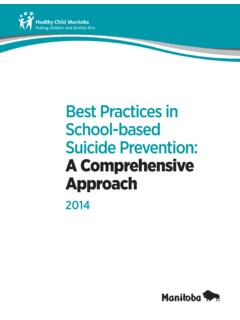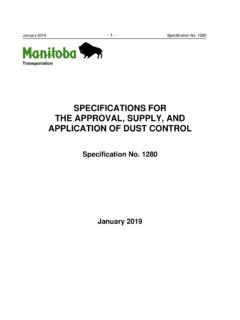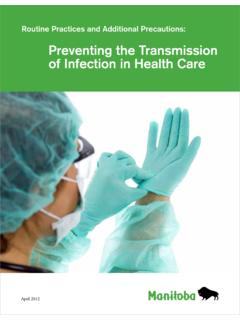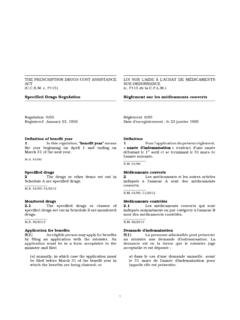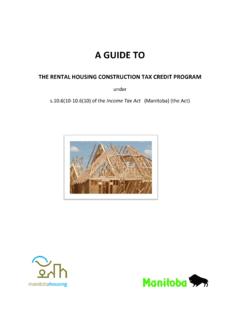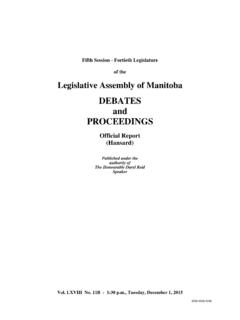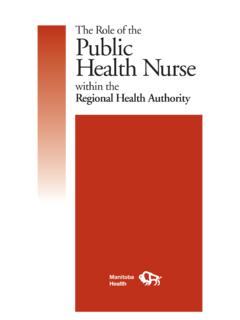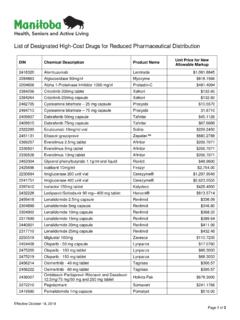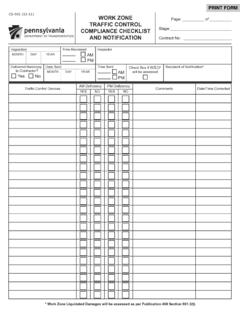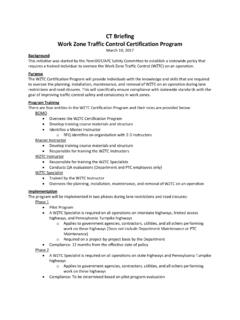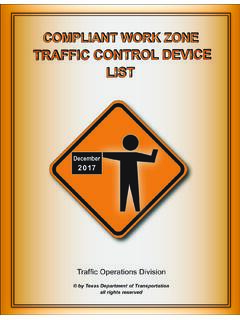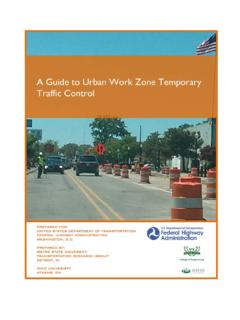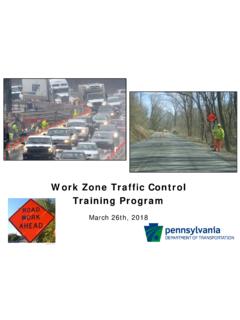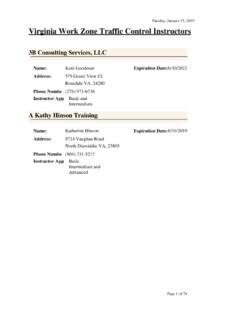Transcription of Work Zone Manual cover 2011 - Province of Manitoba
1 Amendment to the Manitoba Infrastructure and Transportation work Zone traffic control Manual respecting the establishment of Designated Construction zones in Manitoba BACKGROUND In December, 2013, the Government of Manitoba passed Highway traffic Act (HTA) amendments that double the set fines for speeding in a designated construction zone (DCZ). The amendments authorize double fines for speeding: Whether or not there are workers/equipment present; and Whether or not there is a reduction in the maximum speed within the DCZ. The amendments require traffic authorities, and contractors working on their behalf, to establish DCZs, and to identify them using the signage prescribed in the Designated Construction zones Regulation. In addition, the 60 When Passing Workers sign or any similar sign that links a speed reduction to the presence or absence of workers/equipment is now prohibited from use on all highways throughout Manitoba .
2 As a result of the introduction of these regulations, several work Zone Policies, TMP s and STMP s contained in Manitoba Infrastructure and Transportation s work Zone traffic control Manual will need to be revised to comply with the HTA amendments. Until such time as these revisions can be completed and a new edition of the WZTCM issued, this amendment shall provide direction with respect to the establishment of work zones on projects under MIT jurisdiction. DESIGNATED CONSTRUCTION zones A traffic authority/contractor must establish a work site as a DCZ if the work being undertaken on a road meets ALL of the following conditions: 1. work is on the roadway portion of a highway, the area of a highway where vehicles travel, this does not include the shoulder, sidewalk or ditch/median; 2. work is 4 hours or more in duration; 3. work is on a paved roadway; and 4.
3 work is on a road where the maximum speed is 80 km/h or more. If one or more of the above conditions does not apply to the work being undertaken, then the traffic authority is not required to establish a DCZ. For example, a traffic authority would not be required to establish a DCZ if the work is taking place on a gravel road; or on a road where the regular maximum speed is 50 km/h; or when the work is on the shoulder/sidewalk. Optional DCZ s A traffic authority has the option of establishing a work site as a DCZ if doing so will enhance the safety of workers and other road users. To do this, the work being undertaken must be road construction, reconstruction, widening, improvement, repair, or other similar work in relation to the road. DCZ Signage A traffic authority/contractor is responsible to erect/place the approved signage shown below: Designated Construction Zone Sign The beginning of a DCZ must be identified with the Designated Construction Zone sign.
4 Drivers must have an unimpeded view of the sign. This sign will replace the Construction Area sign (MC-1) or the Men and Equipment Working sign (TC-2) in the TMP s and STMP s contained in this Manual . In accordance with MIT s Standard Construction Specifications, Construction Area Signs are also to be installed at the intersection of every Provincial Trunk Highway or Provincial Road that enters onto the project. Construction Ends Sign The end of a DCZ must be marked with the Construction Ends sign (TC-4 or TC-4 DB). Drivers must have an unimpeded view of the sign. Speed Fines Double Warning Sign At least one Speed Fines Double sign (MR-179) must be placed within a DCZ and be no more than 150 m after the Designated Construction Zone sign which marks the beginning of the DCZ. A traffic authority/contractor may place more than one Speed Fines Double sign in a DCZ to heighten driver awareness.
5 The sign may also be used to mark a portion of road within the DCZ that intersects with another roadway. For example, where a high volume road intersects with a DCZ, the traffic authority/contractor may use the Speed Fines Double sign to warn drivers entering the DCZ. Bilingual traffic Signing Bilingual traffic Signing Areas as identified in Policy 900-A-7 of this Manual shall be signed in both official languages using either the bilingual sign, or separate English and French signs with the French sign installed the English sign, at a distance of approximately 30m. SPEED REDUCTIONS Only traffic authorities are authorized to approve speed reductions in work zones . A traffic authority may reduce the maximum speed in all or part(s) of a work zone. Longer work zones may have a number of reduced speed areas to enhance the safety of workers and road users. In the past, traffic authorities/contractors commonly used the 60 When Passing Workers sign to inform drivers to reduce their speed.
6 This sign, and any similar sign that links a speed reduction to the presence or absence of workers/equipment, is now prohibited from use on all highways throughout Manitoba . As a result Policy 900-C-7 in this Manual is no longer valid. Furthermore, any TMP or STMP in this Manual using the 60 When Passing Workers sign shall be modified to eliminate the use of this sign. Speed Reduction Signage traffic authorities/contractors must now identify all maximum speed reductions in work zones using the sequence of regulatory signage detailed below: Reduced-Speed Ahead Warning Sign A reduced-speed ahead warning sign (WB-9) is to be placed in advance of the speed reduction. Maximum Speed Signs The beginning of a reduced-speed area must be identified using a regulatory Maximum Speed sign (RB-1). The end of a reduced-speed area must be identified using a regulatory Maximum Speed sign (RB-1) to inform drivers that they may increase their speed to the normal posted maximum.
7 All existing regulatory speed signs within the reduced speed zone must be covered. Approved Speed Reductions As outlined in Policy 900-C-6 of this Manual , The Director of traffic Engineering has the delegated authority to set speed limits within construction and maintenance areas on provincial highways. The following common work zone conditions and hazards have been granted blanket pre-approval for regulatory speed reductions. All other conditions requiring a speed reduction must be approved in writing by the Director of traffic Engineering (contact MIT s traffic Engineering Branch at 204-945-3781). work ZONE CONDITION / HAZZARD PRE-APPROVED SPEED LIMIT Workers are located in close proximity to traffic (up to a maximum of 12m from an open traffic lane) 60 Km/h A significant unprotected roadside hazard ( excavation area) is located within the clear zone 70 Km/h The conversion of a 4-lane divided highway to 2 lane/2 way operation 80 Km/h A written record detailing the location, time of installation and time of removal of all regulatory speed reductions must be maintained by the traffic authority/contractor.
8 The use of reduced speed limit signs must be limited to those specific sections of highway where the pre-approved condition or hazard exists. They must NOT be used throughout the project unless the pre-approved condition or hazard dictates. Speed limit signs must be removed immediately when the conditions change or hazards no longer exist. MODIFICATIONS TO EXISTING TMP S Until an updated Workzone traffic control Manual is issued, the user of this Manual will be required to modify the TMP s and STMP s contained herein to meet the new regulatory requirements outlined in this amendment. The following three examples are provided to illustrate typical changes required in a unilingual DCZ, in a bilingual DCZ, and in a non DCZ workzone. Sign spacing shall conform to the tables contained within the existing TMP. Enquiries related to the modification of TMP s or STMP s should be directed to traffic Engineering Branch (204) 945-3781.
9 CONSTRUCTIONCONSTRUCTIONAREAENDSandProvi ncial Trunk HighwaysProvincial RoadsEDITION 2013 Infrastructure andTransportationTraffic EngineeringWork Zone traffic control ManualMAXIMUM60 WHENPASSINGWORKERSM anitoba Infrastructure and TransportationDRAFT rev. March 2011 INTRODUCTION work ZONE traffic control Manual This Manual is intended to provide minimum standards for the protection of road users and workers during temporary works relating to highway maintenance and construction, including utility and other operations. This Manual should provide a single source for traffic control standards for use on Manitoba s highways. Over 1000 hard copies of this Manual were circulated since its initial printing in 2000. It has been available on line since March 2002. Please contact the traffic Engineering Branch at (204) 945-3781 for advice and recommendations on dealing with traffic control situations not included in this Manual , or where the standards in the Manual fail to adequately control traffic or protect workers.
10 The following revised standards are based on best practices in Manitoba and in other jurisdictions. They have been revised, refined and adjusted in actual field use. However, they are meant to be open to change and improvement, and we continue to welcome your suggestions, comments and criticisms. traffic controls for temporary conditions often represent a compromise between the time and cost to erect and maintain the necessary devices, and the need to get the job done. We hope this Manual strikes a balance between those conflicting requirements, while providing the necessary protection to both workers and motorists. This 2011 Revision incorporates a few changes and improvements. Director, traffic Engineering Branch work ZONE POLICIES TABLE OF CONTENTS A 900-A-1 Introduction 900-A-2 General Guidelines 900-A-3 Fundamental Principles 900-A-4 Worker Visibility on Roadway 900-A-5 Vehicle Visibility on Roadway 900-A-6 Survey Crew traffic control 900-A-7 Bilingual traffic Signing (incl.)
